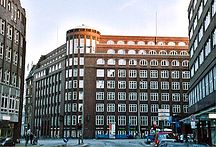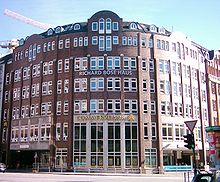Goose market

The Gänsemarkt is a public square on the corner of Dammtorstrasse and Valentinskamp in Hamburg's Neustadt district . In the triangular square near the Hamburg State Opera , several shopping arcades and on the southeast corner also the well-known Jungfernstieg flow .
On the occasion of the 100th anniversary of his death, a monument designed by Fritz Schaper for Gotthold Ephraim Lessing was erected here in 1881 , as Lessing worked as a dramaturge in the former Hamburg company from 1767 to 1770 . On June 18, 1944, air pressure from an explosive bomb toppled the monument. In 1955 it was set up again.
history
The area was leased in 1373 by the then city council (now the Senate ) for a lease of 2½ marks from the cathedral chapter and four shillings for the archbishop of Bremen, but it was not built on until after 1600. With the construction of the Hamburg ramparts (1616–1625), a lime yard was set up here to store the Segeberg lime when construction began ; one of the side streets on the northeast side after this storage area is still called Kalkhof today .
Around 1650, Andreas Heinike acquired the property at Gänsemarkt 44 and built a bakery there, which is still in operation today. In 1655 the square was given the name forum anserum (Latin anser = goose), and since 1709 the name goose market has been common. However, market rights never existed here. Presumably from here the geese were driven to the dam gate . Another theory traces the name back to the owner of an adjacent property Ambrosius Gosen (Plattdtsch. Gos or Goos = goose),
Incoming article: → Oper am Gänsemarkt
On January 2, 1678, the city theater was inaugurated here as the largest civic baroque opera house , where Georg Friedrich Handel worked as a violinist in the opera orchestra in 1704 . From 1722 to 1738 the house was managed by Georg Philipp Telemann . In 1765 the dilapidated opera house was torn down and the Hamburg National Theater was built in its place , where Lessing took over the dramaturgical direction for three years on April 22, 1767. In the same year his Minna von Barnhelm was premiered here.
From the demolition of the Hamburg Mariendome in 1805 until 1881, the Hamburg Cathedral - a Christmas market - had its place. Today, the “largest folk festival in the north” takes place three times a year on the Heiligengeistfeld .
In 1829 the Kalkhof was created as Schwiegerstrasse - named after the previous owner of the site, in 1922 it was renamed Kalkhof . A closed brothel district was created here , which gained a certain fame with the death of the Danish King Frederick VIII on May 13, 1912.
The underground station of the same name on the U2 line has been under the Gänsemarkt since 1970 . In 1986 the square was redesigned after the tram service was stopped in 1978. The Lessing monument was moved to its current location in front of Gerhofstrasse . As part of the extensive redevelopment of the square, which was completed in September 2017, the Lessing monument was moved back to its previous location in the middle of the square.
The Gänsemarktpassage - an indoor shopping arcade over three levels to the Colonnaden - was built in 1980. a. the traditional restaurant Emke give way. The main office of the Hamburger Abendblatt was housed in the one-storey shop front until 1980 ; this too had to give way and is now a few hundred meters away at Großer Burstah 18-32. In 2019 the Austrian Signa Holding acquired the Gänsemarktpassage. A demolition and rebuilding of the passage is planned.
In this area between the Gänsemarkt and the Colonnaden , an English riding stable was built in 1772, the hall of which was renovated in 1885.
Hamburg newspaper district
For technical reasons, daily newspapers were always produced under one roof until the 1970s. At the end of the 1920s, almost all of the major Hamburg daily newspapers resided around the Gänsemarkt:
- the liberal Hamburger Anzeiger , Gänsemarkt 21–23
- the Hamburger Fremdblatt , corner of Große Bleichen / Hohe Bleichen
- the social democratic Hamburger Echo , Fehlandstrasse 11-19
- the communist Hamburger Volkszeitung , Valentinskamp 40–42
- the 8 o'clock evening paper , Alter Steinweg 16
- and the Hamburger Neuesten Nachrichten , Alter Wall 16
building
see also
Northwest end of the goose market
At the confluence of Valentinskamp and Dammtorstrasse , three characteristic "round corners" mark the picture.
- Gänsemarkt 36 - Building of the tax authority
The building of the former finance deputation is an example of the classic Hamburg clinker brick architecture, which was built 1919–1926 by Fritz Schumacher . - Dammtorstraße 2 - Deutschlandhaus
The house is located in the very northern tip. It was built in 1929 by the architects Block & Hochfeld . According to designs by Walther Unruh, the largest cinema in Europe, the UfA-Palast , was built here with 2,667 seats . The former German family department store (DEFAKA) was also located in the same building. It was demolished in 2019. - Gänsemarkt 43 - Richard-Böse-Haus
It forms the third round corner and formerly contained the Commerzbank branch, which has since been closed. The building was built in 1985/86 based on the two large clinker complexes opposite.
Further structures on the Gänsemarkt
- Gänsemarkt 19 - Kontorhaus Gerhofstrasse
The house is located at the confluence of Gerhofstrasse. The building, designed by Carl Elvers and erected between 1881 and 1882, is noticeable for its rich architectural decoration. It is the seat of the jeweler Becker. - Gänsemarkt 21 - 23 - Girardet House (southeast side)
The office building was built in 1896. The design comes from Harry R. Puttfarcken and Emil Janda. - Gänsemarkt 33 - Nicol-Hof (west side)
The commercial building dates from 1905 and was designed by C. Brakhan and Carl Rode. - Gänsemarkt 35 - Lessing-Haus (west side)
The office building is connected to the Nicol-Hof to the north. The diverse masonry, which consists of natural stone on the lower floors and brick above, is striking. The house was built between 1908 and 1909 and was designed by Emil Schaudt and Albert Lindenhorst. - Gänsemarkt 44 - City Bakery House (north side)
The office building with the seat of the city bakery was built in 1913 based on a design by Theodor Speckbötel. In 1976, the right half was added as a twin building in order to achieve a closed development on the edge of the Gänsemarkt. - Gänsemarkt 45 - Opernhof (north side)
This is the successor to the UFA house, which was built in 2007 based on a design by the architect Rolf Reimer. After the German National Theater was demolished, the UFA-Palast was rebuilt here in 1959, and was located in the courtyard of the Deutschland-Haus from 1929 to 1943. The new UFA house only existed for a few decades. After its demolition, the third UFA Palace was built in 1997 in the same place, but it was demolished again in 2006. - Gänsemarkt 50 - commercial building with passage (north side)
The building houses the Gänsemarkt passage , which was built in 1979 and modernized in 2001.
Neighboring structures on Jungfernstieg
- Jungfernstieg 47 - Corner building Jungfernstieg / Gänsemarkt
The building with rounded corners with arched windows and attic floor was renovated in 2010/2011. - Jungfernstieg 48 - Old English Pharmacy
Further east, actually already on Jungfernstieg , is the Old English Pharmacy, originally built in the neighborhood in 1781 . The Evangelische Buchhandlung Tuchel (founded in 1844) had its shop in the neighboring house until 1998, where the Hamburg branch of the White Rose resistance movement met .
Web links
Individual evidence
- ↑ Hugo Schmidt-Luchs, Werner Schmidt-Luchs (ed.) Hamburg Phoenix from the Ashes , image on page 50, Harry v. Hoffmann publishing house. Hamburg 1967
- ↑ Death came with the Sex taz article from March 10, 2003
- ↑ New building project: Signa buys Hamburg's Gänsemarkt-Passage with Loschelder . Juve. Retrieved June 24, 2019.
- ↑ Clemens Zimmermann (ed.), Centrality and Spatial Structure of Large Cities in the 20th Century , page 107, Franz Steiner Verlag 2006, ISBN 3-515-08898-9
Coordinates: 53 ° 33 ′ 18 ″ N , 9 ° 59 ′ 18 ″ E




